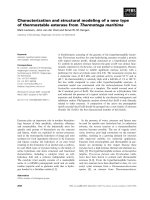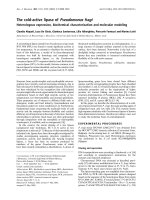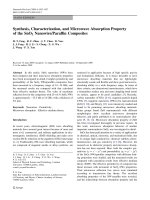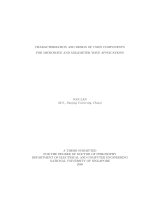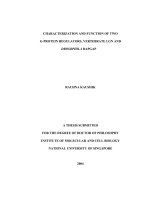Characterization and modeling of microwave spiral inductors and transformers
Bạn đang xem bản rút gọn của tài liệu. Xem và tải ngay bản đầy đủ của tài liệu tại đây (1.18 MB, 172 trang )
CHARACTERIZATION AND MODELING OF
MICROWAVE SPIRAL INDUCTORS AND
TRANSFORMERS
XU DAOXIAN (B. Science)
DEPARTMENT OF ELECTRONICS
PEKING UNIVERSITY, CHINA
A THESIS SUBMITTED
FOR THE DEGREE OF DOCTOR OF PHILOSOPHY
DEPARTMENT OF ELECTRICAL AND COMPUTER ENGINEERING
NATIONAL UNIVERSITY OF SINGAPORE
2005
i
ACKNOWLEDGEMENT
I would like to express my sincere gratitude to my supervisors, A. Prof. Ooi Ban Leong,
Prof. Kooi Pang Shyan, and Dr. Lin Fujiang, for their valuable guidance, advice, and
strong support during my postgraduate program. Without their thorough guidance, this
thesis would not have been completed.
I am also very grateful to Prof. Xu Qunji for his encouragement and useful
discussion.
My gratitude is also extended to my fellow laboratory members, especially for the
assistance and the helpful opinions from Mr. Wu Bin, Mr. Sing Cheng Hong, and Mr.
Hui So Chi.
Last but not least, I would like to thank my friends and family for their generous
support and encouragement throughout my study and research during these years.
ii
CONTENTS
ACKNOWLEDGEMENT i
CONTENTS ii
ABSTRACT vi
LIST OF FIGURES viii
LIST OF TABLES xiv
LIST OF SYMBOLS xv
CHAPTER 1: INTRODUCTION 1
1.1 Background….……………………………………………………………… …1
1.2 Literature Review, Research Motivation, and Goals…….…………………… 3
1.2.1 Circuit Modeling for Microwave Spiral Inductors…………………… 3
1.2.2 Series Resistance of Spiral Inductor with Current Redistribution………4
1.2.3 Series Inductance of Spiral Inductor with Current Redistribution…… 6
1.2.4 High Q Symmetrical Spiral Inductors………………………………….10
1.2.5 Multi-layer Spiral Inductors……………………………………………11
1.2.6 EBG, Power Dividers, and Transformers… ………………………….12
1.3 Organization of the Thesis…………………………………………………… 13
1.4 Original Contributions…………………………… ………………………….15
1.4.1 Book Chapter……… …………………………………………………16
1.4.2 Journals…………………………………………………………… …16
1.4.3 Conferences…………………………………………………………….17
iii
CHATPER 2: IMPROVED MODELING AND PREDICTONS OF RESISTANCE
FOR SPIRAL INDUCTORS WITH EDDY CURRENT EFFECTS 19
2.1 Calculation of Eddy Current…………….…………………………………… 19
2.2 Calculation of the Total Resistance….……………………………………… 22
2.3 Circuit Model Improvement………………………………………………… 25
2.3.1 The Partial Element Equivalent Circuit (PEEC)……………………….25
2.3.2 Circuit Model Improvement with the Eddy Current Effects………… 27
2.4 Experimental Results and Discussions……….……………………………… 31
2.5 Conclusion.…………………………………………………………………….43
CHATPER 3: INVESTIGATION OF INDUCTANCE OF SPIRAL INDUCTOR
WITH NON-UNIFORM CURRENT DISTRIBUTION 51
3.1 Introduction………….…………………………………………………………51
3.2 Fundamental Analysis…………………………… ………………………… 53
3.2.1 Partial Inductance Calculations with Magnetic Flux Method …….… 53
3.2.2 Energy Method in Calculating the Effective Inductance…………… 55
3.3 Derived Inductance Formulae for Spiral Inductor with Non-Uniform Current
Distribution……………………………………………………………………… 58
3.3.1 Self- and Mutual Inductances with Magnetic Flux Method …….… 58
3.3.2 Geometric Mean Distance…………………………………………… 61
3.3.3 Modified Inductance Calculation under Skin Effect………………… 63
3.3.3 Modified Inductance Calculation with Eddy Current ……………… 65
3.4 Results for Typical Geometries… ……………………………………………67
3.4.1 Skin Effect…………………………………………………………… 68
iv
3.4.2 Eddy Current………………………………………………………… 69
3.5 Analysis of Internal Inductance…… ……………….……………………… 72
3.5.1 Internal Inductance of Ground Plane………………………………… 72
3.5.2 Internal Inductance of Metallic Trace of Spiral Inductors…………… 74
3.6 Experimental Results and Discussions……………………………………… 78
3.7 Conclusion.…………………………………………………………………….81
CHATPER 4: DETAILED EXPLANATION OF THE HIGH QUALITY
CHARACTERISTICS OF SYMMETRICAL OCTAGONAL SPIRAL
INDUCTORS 83
4.1 Introduction…………………………………………………………………….83
4.2 Theoretical Analysis………………………………………………………… 84
4.2.1 Change of C
s
……… …………………………………………………84
4.2.2 Changes of R
s
and L
s
… ………………………………………………88
4.2.3 Change of the Electric and Magnetic Centers…………….……………89
4.3 Experimental Results………………………………………………………… 92
4.4 Conclusion.…………………………………………………………………….98
CHATPER 5: AN IMPROVED MODEL OF TWO-LAYER SPIRAL INDUCTOR
WITH EDDY CURRENT EFFECTS IN SUBSTRATE 99
5.1 Introduction…………………………………………………………………….99
5.2 Analysis of Eddy Current in the Substrate… ……………………………… 100
5.3 The Equivalent Circuits for Two-layer Spiral Inductors…………………… 105
v
5.3.1 Conventional Modeling for Multi-layer Spiral Inductors…………….105
5.3.2 Modified Modeling with Eddy Current Effects………………………106
5.3.3 Quality Factor Evaluation…………………………………………….107
5.4 Experimental Results……………… ….……………………………………107
5.4.1 Comparisons of the Simulation Results on Two Different Models… 108
5.4.2 Further Discussion on the Validation of the Improved Circuit Model.110
5.5 Conclusion.………………………………………………………………… 113
CHATPER 6: DESIGNS AND APPLICATIONS 114
6.1 Introduction …………………………. …………………….…………… 114
6.2 Triple-Band Slot Antenna with Spiral EBG……………………… ……… 114
6.3 Modified Wilkinson Power Divider with EBG… ……………………….…121
6.3.1 Introduction……………………………………… …………………121
6.3.2 Experimental Results…………………………………………………122
6.4 Two-layered LTCC Transformer Design based on the Balun Network…… 125
6.4.1 General Review of Monolithic Transformer…………………… … 126
6.4.2 Multifilament Transformer and Baluns………… ………………….129
6.4.3 Design and Fabrication ……………….…… ……………………….132
6.4.4 Transformer Characterization …………….………………………….134
6.5 Conclusion.………………………………………………………………… 137
CHATPER 7: CONCLUSIONS AND SUGGESTIONS FOR FUTURE WORKS 138
7.1 Conclusions…………………………………………… ……………………138
7.2 Recommendations and Suggestions for Future works……………………… 142
REFERENCES 144
vi
ABSTRACT
Radio frequency (RF) circuits fabricated by monolithic microwave integrated circuit
technologies (such as GaAs/silicon MMIC) make extensive use of on-chip transmission
lines to realize an inductance, the inductor being a key component in many high-
performance circuit designs. In this thesis, several kinds of on-chip microwave spiral
inductors are analyzed and modeled.
Some novel predictions of the series resistance and inductance of general spiral
inductors are presented for in this thesis. The resistance of the inductor is observed to
have an increasing function of frequency, whereas the inductance is a decreasing function
of frequency. The non-uniform current in the spiral metallic trace, which is due to skin
effect and eddy current, and the effect of ground plane, results in the frequency-
dependent behavior for the resistance and inductance of the whole spiral inductor. In this
thesis, some closed-form analytical formulae for the resistance and inductance
calculations with detailed consideration of skin effect and eddy current are obtained.
In the approaches above, two different methods for the inductance calculation with
non-uniform current distribution are also investigated and derived. These two methods,
which are mainly based on the magnetic flux and magnetic energy respectively, are
presented for the first time. Then, in the modeling of spiral inductor with partial element
vii
equivalent circuit (PEEC) technique, two improved models with eddy current effects are
proposed.
In this thesis, a new insight for the criteria of obtaining high Q-factor in
symmetrical spiral inductors is discussed. These criteria are based on the overlap
capacitance effects, and the electric and magnetic center (EMC). Compared with the non-
symmetrical spiral inductors, the symmetrical structure can provide a relatively higher
quality factor owing to reduced coupling capacitance. This characteristic is explained
clearly with the concept of EMC of the spiral inductor.
With the new insight gain, a new equivalent circuit for the two-layer spiral
inductors is thus proposed. This circuit incorporates the effect of eddy current of the two-
layer spiral inductors in circuit modeling. Some improved expressions for the eddy
current in the silicon substrate are also derived.
Finally, the research work is extended to cover the analysis of antenna, microwave
transformers, and power dividers. As applications for the spiral inductor, a slot antenna
with spiral EBG-fed, a modified EBG Wilkinson power divider, and a new type of
transformer based on the balun network, are designed and presented in this thesis.
viii
LIST OF FIGURES
Fig. 1.1: Loop and partial inductance…………………………………………………… 8
Fig. 1.2: Photograph of circular symmetrical spiral inductors………………………… 10
Fig. 2.1: Simplified illustration of eddy current effects…………………………………20
Fig. 2.2: Calculated B-field on a square spiral inductor (N=6, W=18
m
µ
, and D=350 m
µ
)
(after [2])………………………………………………………………… 21
Fig. 2.3: The basic PEEC example. The example shows a part of a flat wire subdivided
into three capacitive and two inductive PEEC lumps. The three solid rectangles are the
capacitive cells and the two dashed ones are the inductive cells. The black dots are the
circuit nodes after [36]………………………………………………………………… 25
Fig. 2.4: The PEEC model for the basic example as shown in figure 2.3. The partial
mutual coupling between
22p
L
and
44p
L
is not shown after [36]……………………… 27
Fig. 2.5: Conventional circuit models for spiral inductors…………… …………… 28
Fig. 2.6: Illustration of modified part after de-embedding………………………… 29
Fig. 2.7: Modified circuit models for spiral inductors………………… ………… … 30
Fig. 2.8: Geometry of spiral inductor………………………………………………… 31
Fig. 2.9: Magnitude difference of S-parameter simulation results on the conventional
model in Fig. 2.5 (a) and the modified model in Fig. 2.7 (a)……………………… 32
Fig. 2.10: Phase difference of S-parameter simulation results on the conventional model
in Fig. 2.5 (a) and the modified model in Fig. 2.7 (a)…………………………… …….32
Fig. 2.11: S-parameter simulation results on modified circuit model in Fig. 2.7 (a) of
Inductor 1 (blue line: measured data; red line: simulated data)………………………….33
ix
Fig. 2.12: S-parameter simulation results on conventional circuit model in Fig. 2.5 (a) of
Inductor 1 (blue line: measured data; red line: simulated data) …………………………33
Fig. 2.13: S-parameter simulation results on modified circuit model in Fig. 2.7 (b) of
Inductor 1 (blue line: measured data; red line: simulated data) …………………………34
Fig. 2.14: S-parameter simulation results on conventional circuit model in Fig. 2.5 (b) of
Inductor 1 (blue line: measured data; red line: simulated data) …………………………34
Fig. 2.15: Difference of S-parameter simulation results on the conventional model in Fig.
2.5 (b) and the modified model in Fig. 2.7 (b) for Inductor 1… ………………………35
Fig. 2.16: Measured and simulated results of the real part of
1
2
−
Y (a) and
ω
)(
1
1
2
−
−
Yimag
(b) on Inductor 1 with improved models…………………………… ………………….38
Fig. 2.17: Measured and simulated results of the real part of
1
3
−
Y (a) and
ω
)(
1
1
3
−
−
Yimag
(b) on Inductor 1 with improved models……………………………………………… 39
Fig. 2.18: General
π
-mode reciprocal network form of inductor…………………… 40
Fig. 2.19: Real part of input impedance of Inductor 3 and Inductor 4 after de-
embedding……… ……… 41
Fig. 2.20: S-parameter simulation results on modified (Fig. 2.7 (b)) and conventional (Fig.
2.5 (b)) circuit models of Inductor 5…………………………………………………… 44
Fig. 2.21: S-parameter simulation results on modified (Fig. 2.7 (b)) and conventional (Fig.
2.5 (b)) circuit models of Inductor 6…………………………………………………… 45
Fig. 2.22: S-parameter simulation results on modified (Fig. 2.7 (b)) and conventional (Fig.
2.5 (b)) circuit models of Inductor 7…………………………………………………… 45
x
Fig. 2.23: S-parameter simulation results on modified circuit model (Fig. 2.7 (a)) of
Inductor 8…………………………………………………………………………… 46
Fig. 2.24: S-parameter simulation results on modified circuit model (Fig. 2.7 (a)) of
Inductor 9…………………………………………………………………………… 46
Fig. 2.25: S-parameter simulation results on modified circuit model (Fig. 2.7 (a)) of
Inductor 10…………………………………………………………………………… 47
Fig. 2.26: S-parameter simulation results on modified circuit model (Fig. 2.7 (a)) of
Inductor 11…………………………………………………………………………… 47
Fig. 2.27: S-parameter simulation results on modified circuit model (Fig. 2.7 (a)) of
Inductor 12…………………………………………………………………………… 48
Fig. 2.28: S-parameter simulation results on modified circuit model (Fig. 2.7 (a)) of
Inductor 13…………………………………………………………………………… 48
Fig. 2.29: S-parameter simulation results on modified circuit model (Fig. 2.7 (a)) of
Inductor 14…………………………………………………………………………… 49
Fig. 2.30: S-parameter simulation results on modified circuit model (Fig. 2.7 (a)) of
Inductor 15…………………………………………………………………………… 49
Fig. 2.31: S-parameter simulation results on modified circuit model (Fig. 2.7 (a)) of
Inductor 16…………………………………………………………………………… 50
Fig. 3.1: Illustration of two straight conductors……………… …………………….….53
Fig. 3.2: Mutual inductance M in relation to the self-inductance
1
L and
2
L ………… 59
Fig. 3.3: Illustration of the rectangular cross section of two equal conductors…… 62
Fig. 3.4: Dividing method on the cross section of metallic trace under skin effect…… 63
Fig. 3.5: Dividing method on the cross section of metallic trace with eddy current…….66
xi
Fig 3.6: Illustration of the filament self-inductance weights and the current density under
skin effect……………………………………………………………………………… 69
Fig. 3.7: Description of eddy current in inductor….…………………………………….70
Fig. 3.8: Two unequal parallel filaments……………………………………………… 70
Fig. 3.9: Self- and internal ground inductances for the spiral inductors……………… 73
Fig. 3.10: Equivalent circuit models for skin effect…………………………………… 75
Fig. 3.11: Computational skin-effect internal inductance of solid rectangular conductors
of pure copper………………………………………………………………………… 78
Fig. 3.12: Equivalent circuit of an inductor………………………………………… 80
Fig. 3.13: Comparison between the measured and simulated inductance of spiral
inductors………………………………………………………………………………….80
Fig. 4.1: (a) A non-symmetrical, spiral inductor. (b) A symmetrical, spiral inductor….85
Fig. 4.2: A typical circuit model for a spiral inductor………………………………… 85
Fig. 4.3: (a) A non-symmetrical, octagonal spiral inductor. (b) A symmetrical, octagonal
spiral inductor……………………………………………………………………………88
Fig. 4.4: A simplified lumped element model of a spiral inductor………………… 90
Fig. 4.5: Comparisons of the simulated quality factors between symmetrical and non-
symmetrical spiral inductors……………………… ……….………………………… 92
Fig. 4.6: Comparisons of the simulated quality factors between the symmetrical spiral
inductors with regular spacing and irregular spacing (24
m
µ
metal width, and 366
m
µ
outer dimension)…………………………………………………………………… ….95
Fig. 4.7: Measured quality factors for various spiral inductors…………………………96
Fig. 5.1: Illustration of eddy current in the substrate of two-layer spiral inductors……101
xii
Fig. 5.2: One kind of conventional equivalent circuit for two-layer spiral inductors….106
Fig. 5.3: Modified equivalent circuit for two-layer spiral inductors……… …… 106
Fig. 5.4: Illustrations of comparisons of the S-parameters between the measured data
(solid line) and the simulated data on the conventional model (point line) and the
modified model (dashed line)………………………………………………………… 109
Fig. 5.5: Comparisons of the simulations results for the S-parameters with different
models………………………………………………………………………………… 110
Fig. 5.6: Comparisons of the real and imaginary parts of
12
Y
−
between the measured data
(point line) and simulated data (dashed line) with the improved model on different
inductors……………………………………………………………………………… 111
Fig. 5.7: Illustration of the measured (solid line) and simulated (circular mark) quality
factors of different two-layer spiral inductors………………………………………….112
Fig. 6.1: Geometric dimensions of multi-band slot antenna with EBG feed………… 115
Fig. 6.2: Fabricated slot line antenna with conventional CPW feed………………… 116
Fig. 6.3: Fabricated slot line antenna with spiral EBG feed. ………………………… 116
Fig. 6.4: Simulated return loss of EBG-fed slot antenna and reference antenna. …… 117
Fig. 6.5: Simulated and measured return loss of reference antenna. ………………… 117
Fig. 6.6: Simulated and measured return loss of EBG-fed slot antenna……………… 118
Fig. 6.7: Measured return loss of EBG-fed slot antenna and reference antenna. …… 118
Fig. 6.8: E-plane of EBG-fed antenna at 1.92GHz. ………………………………… 119
Fig. 6.9: H-plane of EBG-fed antenna at 1.92GHz. ………………………………… 119
Fig. 6.10: E-plane of EBG-fed antenna at 2.4GHz. ………………………………… 120
Fig. 6.11: H-plane of EBG-fed antenna at 2.4GHz………………………………… 120
xiii
Fig. 6.12: E-plane of EBG-fed antenna at 3.22GHz. ………………………………… 121
Fig. 6.13: H-plane of EBG-fed antenna at 3.22GHz. ………………………………….121
Fig. 6.14: Equivalent circuit of the Wilkinson power divider. ……………………… 122
Fig. 6.15: Structure of power divider with EBG. …………………………………… 123
Fig. 6.16: Fabricated modified Wilkinson power divider with EBG. ……………… 123
Fig. 6.17: Simulated return loss of the input port of power dividers with EBG and without
EBG. ………………………………………………………………………………… 124
Fig. 6.18: Insertion loss of the power divider with EBG. …………………………… 124
Fig. 6.19: Return loss of the power divider with EBG. ……………………………… 125
Fig. 6.20: Monolithic transformer. (a) Physical layout. (b) Circuit model…………….127
Fig. 6.21: (a) Square bifilar balun layout. Schematic symbols of bifilar (b) and trifilar (c)
balun…………………………………………………………………………………….130
Fig. 6.22: Transmission line model for the Marchand balun…………… …………….131
Fig. 6.23: The cross section view of the multi-layer transformers….………… …… 132
Fig. 6.24: Two-layer transformer structure with spiral inductors……… ……… 133
Fig. 6.25: Microphotograph of fabricated transformer… …… …………………… 134
Fig. 6.26: Insertion loss of transformer ……………… …………………………… 135
Fig. 6.27: Return loss of transformer………………… …… …………….…… 135
Fig. 6.28: Simulated and measured phase difference of the balanced outputs of
transformer…………………………… ………………………………………………136
Fig. 6.29: Simulated and measured amplitude difference of the balanced outputs of
transformer …………………………………………………………………………136
xiv
LIST OF TABLES
Table 2.1:
Geometric parameters of spiral inductors……………………………………32
Table 2.2: Extracted values of circuit components from circuit optimization for Inductor
1.…………………… …………………………………………………………… … 36
Table 2.3: Detailed parameters of other sample inductors……………….…… …… 42
Table 3.1: Values of
2
K
between straight traces of the inductor……… …………… 71
Table 5.1: Geometric parameters for two-layer spiral inductors…………………… 108
Table 5.2: Extracted lumped-elements in the improved circuit model……………… 109
Table 5.3: Illustrations of the comparison results of the extracted lumped-elements in
both the conventional and improved models for Inductor 36… ………………………112
Table 6.1: Geometric parameters (in mm) for reference antenna and EBG-fed
antenna………………………………………………………………………………….115
Table 6.2: Comparison of measured performance between reference antenna and EBG
antenna 116
Table 6.3: Geometric parameters (in mm) for the modified Wilkinson power divider with
EBG…………………………………………………………………………………… 124
xv
LIST OF SYMBOLS
ε
Permittivity
0
ε
Permittivity of free space
µ
Permeability
0
µ
Permeability of free space
σ
Conductivity
δ
Skin depth
E
Electrical field intensity
B Magnetic flux density
φ
Magnetic flux
f Frequency
ω
Angular frequency
L Inductance
M Mutual inductance
R Resistance
Z Impedance
Y Admittance
C Capacitance
Q Quality factor
i Current
J Current density
xvi
D Outer dimension of spiral inductor
d Inner dimension of spiral inductor
W Metal width of spiral inductor
T Metal thickness of spiral inductor
P Metal pitch of spiral inductor
S Spacing between the metallic traces of spiral inductor
q Charge
U Voltage
Φ Potential
1
CHAPTER 1
INTRODUCTION
1.1 Background
During the past few years, more and more microwave design efforts have been focused
on integrating voltage-controlled oscillator (VCO) cells, including the passive
LC tank,
into a single chip while achieving low phase-noise performance [1]. To ensure a very low
phase-noise signal, the existence of a high-quality
LC resonator for the VCO is demanded.
The quality of the resonator circuit is dominated by the quality factor of the on-chip
inductor. Hence, successful design of such a passive device in most of the available
technologies remains a major issue.
On-chip microwave spiral inductors generally enhance the reliability and efficiency
of silicon-integrated RF cells. They can offer circuit solutions with superior performance
and contribute to a higher level of integration [2]-[3]. In low-noise amplifiers (LNA’s),
microwave integrated inductors can be used to achieve input-impedance matching
without deteriorating the noise performance of the cell [4]. They can also be used as loads
intending either to improve the gain capability of the amplifier or to reduce its power
consumption [5].
2
The industry has already appreciated the benefits of high-quality integrated
inductors and is willing to adapt the existing processes in order to achieve improved
inductive elements. The inclusion of Au or Cu metallic layers, the increase of the
thickness of metal alloys and dielectric materials, and the increase of the substrate
resistivity [6] are among the changes that will help to accomplish quality-factor values of
above 15 in silicon technologies. High-
Q-factor on-chip spiral inductors can give the
opportunity to implement reliable on-chip passive RF filters on silicon substrates.
Significant efforts have already been reported [6]-[25] in literature that aim to
provide high-
Q-factor inductors for critical RF applications. During this period, new
structures such as 3-dimensional, multi-layer, vertical, and symmetrical inductors, were
created. Multi-layer spiral inductor offers an increase in the total inductance, when
compared with planar inductor occupying the same area. Through experiments, the
symmetrical structure of a spiral inductor shows a relatively higher
Q-factor than the
asymmetrical one.
A first-time success in silicon technology is the ultimate target in every Radio
Frequency Integrated Circuit (RF IC) design. This goal becomes more difficult to achieve
as the frequency of operation increases. The inclusion of a poorly characterized element
such as the integrated inductor in a design turns the whole process to an extremely risky
matter. The aim of this work is to minimize the risk, the time, and the cost of the
inclusion of integrated inductor structures in silicon RF IC design. This is achieved
3
through the systematic presentation of the properties and nature of the integrated spiral
inductors, as well as the numerous design cases, parametric evaluation, and nomographs
that will allow the engineer to gain insight in Si inductors.
1.2 Literature Review, Research Motivation, and Goals
1.2.1 Circuit Modeling for Microwave Spiral Inductors
In conventional IC technologies, inductors are not considered as standard components
like transistors, resistors, or capacitors, whose equivalent circuit models are usually
included in the process description. However, this situation is rapidly changing as the
demand for RF IC’s continues to grow [17], [20], and [26]-[28]. So, an accurate model
for on-chip inductors is of great importance for silicon-based radio-frequency integrated
circuits designers. Various approaches for modeling inductors on silicon have been
reported in the past several years [29]-[46]. Most of these models are based on numerical
techniques, curve fitting, or empirical formulae, and are therefore relatively inaccurate or
not scalable over a wide range of layout dimensions and process parameters.
To gain a greater insight into the design of the spiral inductor, a compact, physical
model is required. The partial element equivalent circuit (PEEC) technique has been
applied successfully for many years to model the electrical properties of high-speed
interconnect [36]-[38] and found suitable for the spiral inductor modeling [39]. The
circuit model introduced firstly in references [40]-[41] presents the good physical
inductor model, which maintains the relevant parasitic and their detailed effects. Then in
4
[42], another modified circuit model, in which some additional components were added,
was introduced. The added components in the modified circuit model represent the loss
mechanism of the substrate of spiral inductors.
A frequency-dependent circuit model is required by incorporating the eddy current
effect for the spiral inductors. This is one of the most important goals for our research.
1.2.2 Series Resistance of Spiral Inductor with Current Redistribution
Spiral inductors implemented in silicon processes suffer from several power dissipation
mechanisms, leading to poor inductor quality factor. The mechanisms include (
a) R
I
2
losses from eddy current circulating below the spiral inductor in the semiconducting
substrate, (
b) from displacement current conducted through the turn-to-substrate
capacitances and (
c) the underlying substrate material, and (d) from the primary inductor
current flowing through the thin metallic traces of the inductor itself [32], and [47]-[49].
Spiral inductors built by bipolar processes (or bipolar-derived BiCMOS) often exhibit
higher
Q-factor values (typically five to ten). This is mainly due to the relatively high
substrate resistivities (e.g.,
cm
−
Ω
− 3010 ), which reduce the eddy current but may still
suffer from significant losses from the displacement current conducted through turn-to-
substrate capacitances [27] and [32]. These losses can be mitigated by the introduction of
a patterned ground shield [6] and [50] or by an umpatterned shield of the proper sheet
resistance placed below the inductor [51], of course both at the expense of reduced self-
resonance frequency.
5
The best approach to produce high-quality inductors in silicon involves (
a) etching
away the offending semiconducting material below the spiral inductor [7], (
b) using a
thick oxide layer to separate the spiral inductor from the substrate [23] and [52], (
c) using
a very high resistivity bulk [30], or (
d) using an insulating substrate such as sapphire [53].
In some of these cases, inductor
Q-factors of 20 or above were reported, with the highest
values found in single turn spiral inductors with the inductance values of less than 5nH.
Unfortunately, for spiral inductors with higher inductances, multiple turns are
required and the
Q-factor often falls and is lower than the value that would be predicted
from a simple calculation of inductor reactance divided by
dc series resistance. The
limitation on
Q-factor can be traced to an increase in effective resistance of the metallic
trace at high frequencies due to the phenomenon of current redistribution [22] and [45].
The concept of current redistribution in the metallic trace of spiral inductor can
mainly be traced from two aspects: skin effect and eddy current. Skin effect is the
universal phenomenon in RF IC, and eddy current, which leads to the current crowding,
is also well-known and the general mechanisms involved were cited and elucidated in
several papers, such as references [22], and [45]-[46]. But little information is available
in the literature to quantitatively predict the eddy current without resorting to numerical
simulations [46]. The authors of [2] developed a first-order analytical model for the major
current crowding mechanisms and derived some useful approximate formulae for
calculating the eddy current.
6
In [41], a physical expression of the series resistance of a spiral inductor with skin
effect was proposed and given as
,
eff
WTlR
ρ
=
(1.1)
where
ρ
, W, and l represent the resistivity, metallic width, and total length of the spiral
inductor, respectively.
eff
T
is defined as an effective thickness:
),1(
δ
δ
T
eff
eT
−
−=
(1.2)
where T and
δ
represent respectively the metal thickness and the skin depth. For
frequencies below 2GHz, the skin depth effects are relatively small in most processes
since the trace metal thickness is typically less than or equal to the skin depth. Above
2GHz, the alternating current (ac) resistance increases and approaches an asymptote
proportional to the square root of frequency. In contrast to the skin effect in high
frequency range, current crowding (eddy current in the metallic trace of the spiral
inductor) is a strong function of frequency, resulting in an increasing resistance function
and a concaving downward Q-factor function.
Kuhn’s formulae in [2] provided a series of improved expressions, incorporating
the eddy current, for the prediction of series resistance of a spiral inductor. But the skin
effect on the resistance was neglected in the estimation. In our approach, we will provide
some more accurate expressions of resistance with both the skin effect and the eddy
current in spiral inductors.
1.2.3 Series Inductance of Spiral Inductor with Current Redistribution
7
Since an inductor is intended for storing magnetic energy only, an ideal expression of its
inductance in terms of width, gap spacing and length is essential in terms of equivalent
circuit modeling. A very accurate numerical solution can be obtained by using a three-
dimensional (3-D) finite-element simulator such as MagNet [54], but 3-D simulators are
computationally intensive and time-consuming. Other techniques for analysis include the
Greenhouse method [40] and [55], Wheeler formula [56], and “Data Fitted Monomial
Expression” [57]. Data fitted expressions usually lack the precise theoretical
interpretation, while physical foundation for computing inductance is built on the concept
of the self-inductance of a wire and the mutual inductance between a pair of wires.
The total inductance of a spiral inductor can be separated into two aspects, the self-
and mutual inductances. A comprehensive collection of formulae and tables for
inductance calculation was summarized by Grover in [58].
The partial inductance method has been widely applied to the calculation of
inductance of spiral inductors [40]. The concept and computation of partial inductances
were described in [59], and the working formulae were given elsewhere. Partial
inductances conceptually involve magnetic flux between a conductor and infinity. This
aspect presents obvious problems in structures of infinite length such as the conventional
transmission line. Perhaps the most important quality of the partial inductance concept is
the ability to break a complicated three dimensional problem into its constituent
interactions. A very simple example of a loop and its partial inductances is given in Fig.
8
1.1. The equivalent circuit of the loop in Fig. 1.1 is specified in terms of partial
inductances
ii
L
of the i-th segment and
ij
L
between the i-th and the j-th segments. If the
loop is closed so that
4321
IIII
=
==
, then the total loop inductance can be obtained
with conventional circuit theory as
.
4
1
4
1
∑∑
==
=
mn
mn
LL
(1.3)
11
L
44
L
33
L
22
L
1
3
2
4
Fig. 1.1: Loop and partial inductance.
The mutual partial inductance can often be approximated for realistically spaced
conductors by resolving the conductor cross sections into filaments and summing the
results as
,
1
11
∑∑
==
=
i
j
n
i
n
j
fij
ji
ij
L
nn
L
(1.4)
where
fij
L
is the mutual inductance between the filaments.
The typical formula for the calculation of inductance of spiral inductor is [41]
,2)
3
5.0
2
(ln2 lX
l
TW
TW
l
lMLL
selftotal
+
+
++
+
=+= (1.5)
where l, W, and T represent the total length, metal width, and metal thickness of the spiral
inductor. X is the mutual inductance parameter, which can be computed using

